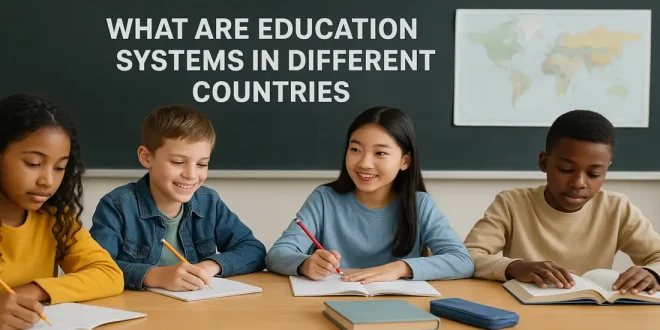What are Education System in Different Countries
Every nation relies on education to shape social, cultural, and economic development. Depending on each nation’s history, culture, economy, and government priorities, education systems, education development, and education policy diverge. Education’s primary objective, however, remains constant: knowledge, skills, and values acquisition. Analysis of education systems reveals insights into national priorities and the vision governments have for their citizens.
United States
The United States education systems are flexible, diverse, and creativity driven. Education policy is federal, state, and local, where each state determines its own policies and curricula. Children are educated from ages five to around to high school, and then to colleges and universities. Unlike many other systems, American education places importance on critical thinking, and problem solving, and encourages students to shape their education around their interests and career aspirations. Students are also encouraged to partake freely in extracurricular activities.Unfortunately, several issues remain. They include unequal access to resources nationally, unequal access to resources regionally, and the impact of student debt in higher education.
United Kingdom
The United Kingdom fuses old world academia with new world pedagogy. The United Kingdom has a primary, secondary, further and higher education system, made of up of several integral and connected pieces. There are several major cons, the heavy focus on standardized testing in the form of the GCSE and A Level exams, and the ability of a student to attend university. There is a strong focus on the fundamentals of Western education (English, Mathematics, and the Sciences). There are world class institutions (and a world class reputation) in the forms of Cambridge and Oxford universities. There is a world class education system in the United Kingdom but unlike popular believe, the United Kingdom is not a world education superpower. Educational competition is fierce and within the same geographical unit, the education system is unbalanced.
Finland
Finland has a world reputation for their education system and rightfully advocates for equality in education. The trust placed with students and their families enables the minimal levels of stress within the system. Children are introduced to formal schooling at the age of 7 and placed in a classroom with minimal standardized tests. Teachers are scholars and are to be respected. The system encourages and enables teachers to attain a master’s degree.Finland focuses on student well-being, personalization, and cooperative learning within the classroom, instead of rote learning and competition. This additional perspective has produced consistently high performance and satisfaction. However, as the world changes, so does the need for Finland to embrace a digital dimension and teach learners to navigate an interconnected global environment.
Japan
Japan is yet another country recognized for its outstanding academic performance as well as for its rigidly disciplined educational system. The educational culture in Japan schools promotes respect, hard work, and a sense of community. The core subjects of the curriculum, mathematics, science, and language, form the pillars of a strong academic training. The educational system also integrates elements of moral training and character building, so that students grow into responsible and respectful citizens. The highly competitive entrance examinations often define the academic trajectories of students, which in turn, invites them to attend “juku” actively. While this system indeed brings up high-achieving students, it also imposes a lot of pressure, and limits imagination and individuality.
Germany
The distinctiveness of Germany’s dual education system combines academic learning with practical vocational training. Students are assigned to different types of secondary schools after primary school based on skills and career aspirations. It is this tracking of students that allows them to take university academic routes or vocational pathways that directly leads to jobs at the sectors of industry. The results are the highly-skilled and qualified workforce and low youth unemployment. Plus, higher education is free or very affordable, even for international students. The system has its drawbacks, and critics point out that such tracking of students early on can close opportunities for those who may develop at an advanced academic intervals later on.
Canada
Undoubtedly, the world best education system is in Canada. Schools ‘Equality, Multicultural, and Bilingual programs and Policies enable citizens to be educated in both official languages (French and English). Schools system (curriculum, education, and training) is centrally managed and for every province in the country. Canada is one of the best-performing countries in the world, and in most academic disciplines. The recognition and policy to support and include educational system for the under-privileged and indigenous communities is an inclusion that the world can be proud of. However, challenges, including resource disparities across provinces and fierce competition to enroll in elite universities, still exist.
China
Determined to improve academic performance and discipline, along with national progress, the nation has adopted a rigid and challenging education system. Being the second biggest education system in the world, China also focuses on mathematics, science, and technology. Schoolchildren invest long hours of study, and the Gaokao, the national university entrance exam, is world renowned for being the most challenging. Academic futures is decided primarily on the exam results, hence a stressful competition and large educated labor force for the economy. Criticism of the education system primarily focuses on rote learning and the need of the educators to reduce stress on the learners.
Comparative analysis of the different education systems shows a different and interesting approaches to the same problem. The US and Australia depict innovation, diversity, and freedom, whereas China and Japan depict rigidity, discipline, and rigorous academics. Equal opportunities to the students and their well being is prioritized in Finland and Canada, on the other hand, Germany focuses on the practical skills of the students. The UK has a modern education system. It offers a blend of tradition and future to the students.
It’s obvious that no one education system is the “best.” Each system is a reflection of the values and priorities of their respective societies: systems that focus on equity and whole person-development versus those that emphasize academic high achievement and intense rivalry. As the world continues to face challenges, including technological advances, a climate crisis, and social inequities, the world’s education systems must continue to evolve and include teaching new competencies, lifelong learning, and global citizenship.
Yet, more than a system of education, people use it to delineate the future of a nation. Education is a great model to study because it exposes a nation’s strengths and weaknesses. When it comes to complex issues, it is great to study and shape more effective models. The world’s education systems demonstrate that, although divergent, the systems all aim to equip people with the necessary skills to navigate a world that is forever changing.

